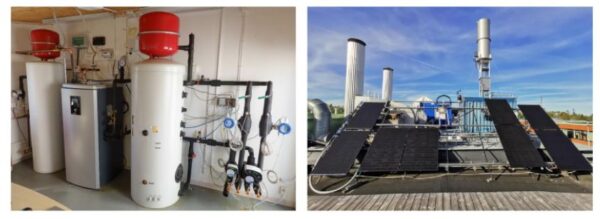Researchers at the KTH Royal Institute of Technology in Sweden claim to have identified the techno-economic optimal system design for coupling a ground source heat pump (GSHP) with photovoltaic-thermal (PVT) energy.
The scientists designed the system with roll-bonded PVT collectors with embedded channels between two rolled aluminum sheets, which have a higher heat transfer coefficient compared to conventional PVT panels using sheet and tube absorbers.
“A drawback of the roll bond design is a larger pressure drop, which was found to be more than twice as high as the reference sheet and tube PVT under same operating conditions,” they explained. “A box-channel design can be used to increase even more the heat transfer area between absorber and fluid.” They also noted, however, that roll-bonded panels have higher manufacturing costs.
The research team tested the roll-bonded collectors at fluid temperatures below ambient in combination with a GSHP under wide range of low-temperature operating and weather conditions through outdoor laboratory experiments in Stockholm. In the proposed system configuration, the PVT collectors act as secondary heat sources.
“The ISO 9806:2017 standard testing is used as a basis for thermal performance evaluation, although the fact that tests are done at temperatures below ambient and dew point is an exception from the standard,” the academics specified.
The techno-economics analysis assumed the system to be deployed in a multi-family house with a total heated area of 2,000 m2, a space heating demand of 125 kWh/m2a, and a domestic hot water (DHW) demand of 38 kWh/m2a. The system comprised an 88 kW GSHP and 144 roll-bonded south-oriented PVT collectors deployed with a tilt angle of 45 degrees.

Popular content
The system included a hot water storage tank and a 10 kW air-water heat exchanger for dissipation of the heat generated by the heat pump. The performance of the system was compared with that of a reference system with conventional PVT collectors.
The tests showed that the box-channel propylene PVT collectors produce more heat per square meter compared to their conventional counterparts, while also showing a 34.4 % lower thermal production. Furthermore, the roll-bonded collectors were found to be 9% more expensive than the reference panels.
“Of the non-finned designs, the sheet and tube has a similar thermal unit cost as the finned box channel aluminum design, but produces 40 % less heat per square meter annually,” the academics emphasized, noting that the roll bond design results in an overall better performance.
“This approach will allow for an in-depth exploration of their effects on borehole regeneration and heat pump performance, ultimately enabling the identification of the techno-economic optimal design for integrating PVT collectors with ground source heat pump systems considering PVT, borehole and energy prices,” they said, referring to the future direction of their work.
The system was presented in the study “Empirical investigation of solar photovoltaic-thermal collectors for heat pump integration,” published in Applied Thermal Engineering.
Another research group at the KTH Royal Institute of Technology recently investigated the potential coupling of a GSHP with both photovoltaic-thermal (PVT) energy and free cooling (FC).
This content is protected by copyright and may not be reused. If you want to cooperate with us and would like to reuse some of our content, please contact: editors@pv-magazine.com.



By submitting this form you agree to pv magazine using your data for the purposes of publishing your comment.
Your personal data will only be disclosed or otherwise transmitted to third parties for the purposes of spam filtering or if this is necessary for technical maintenance of the website. Any other transfer to third parties will not take place unless this is justified on the basis of applicable data protection regulations or if pv magazine is legally obliged to do so.
You may revoke this consent at any time with effect for the future, in which case your personal data will be deleted immediately. Otherwise, your data will be deleted if pv magazine has processed your request or the purpose of data storage is fulfilled.
Further information on data privacy can be found in our Data Protection Policy.